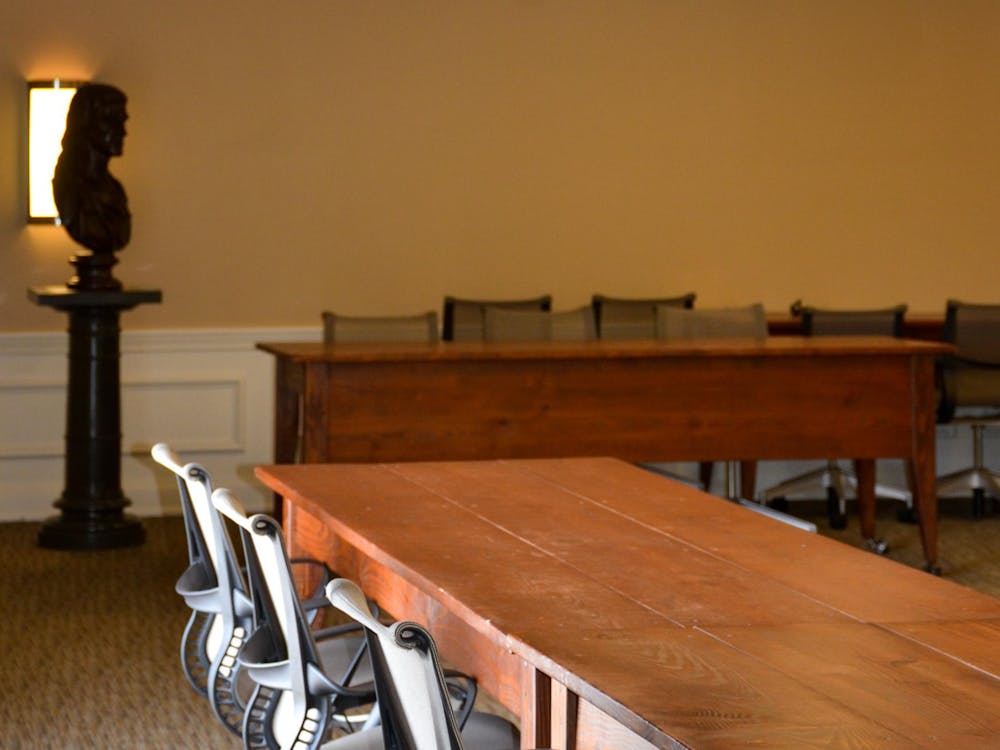Men may no longer stamp their feet to intimidate women when they enter the classroom or answer a question in class, but today at the University a variety of challenges still exist for many women ranging from self-esteem issues to a limited number of female faculty to a controversial procedure for reporting sexual assaults.
Raising the bar?
Though the University was one of the top schools in the country prior to 1970, it still enrolled a significant number of students who were less academically inclined. That all changed, however, with the admission of women.
There used to be a "happy bottom quarter," said Ann Brown, a College graduate from the first co-ed class at the University. There was a "group of men in the class who were happy with the 'Gentleman's C' and not academically focused. That part of the University is gone. The average quality of the classes is significantly higher and that can definitely be attributed to coeducation."
Statistics seem to bear out Brown's assertion. Over the past 35 years, the percentage of women at the University has steadily increased from roughly one-third in the first coed class of 1970 to over 50 percent today, according to the University's Office of Institutional Assessment and Studies.
Over the same period, the mean GPA of undergraduate students increased from 2.938 in 1984 to 3.157 in 2004, with the average GPA for women consistently higher than the average for men. The University also has been gradually more selective, receiving more applications and offering admission to a smaller percentage of applicants between 1984 and 2004.
Not everyone, however, believes there is a correlation. Politics Prof. Larry J. Sabato said he thinks the higher academic standards present at the University today are not because of women but rather are the result of an overall trend of more talented students of both genders applying.
The University is "less of a party school, because the students are more competitive and serious," Sabato said. "Life is very different now. Back in the early 70s, if you had a degree from U.Va., you had a very good chance of a successful life. [Now] a B.A. is just the beginning."
By the numbers
Although women make up 56 percent of this year's entering class, the numbers are not equal across all schools. For example, in the class of 2004, women made up more than half of the College and Architecture School and 80 to 90 percent of the Education and Nursing Schools but only 44 percent of students enrolled in the Commerce School and one-quarter in the Engineering School, according to statistics from the University's IAS Office.
The percentages of women in graduate and professional education at the University also are slightly lower, with graduate schools comprised of 48 percent women and law and medicine containing 44 percent.
Jill Raney, former president of Allies of Women Attaining Knowledge and Enrichment and current co-vice president of the Queer Student Union. said she is working towards a minor in computer science and said she feels slightly uncomfortable with the lack of female students in her classes.
"What I've seen in the E-School has not been as great" as in the College, Raney said. "In my CS classes, there are usually six other girls there, and it's not quite as comfortable of an atmosphere overall."
Various student organizations try to interest female students in the more male-dominated fields. The Commerce School promotes women in business through the McIntire Women's Business Forum, the Engineering School in the Society of Women Engineers and the Medical School through the Women in Medicine Initiatives.
The University also has taken steps to try to bring women into those academic areas traditionally dominated by men.
According to Dean of Admissions John Blackburn, the Admissions Office is always interested in recruiting female students for engineering programs. This year's incoming class contains 132 women engineers -- about 26 percent -- which is about the same percentage as entering classes over the past 20 years.
Other male-dominated domains, such as the Commerce School, have remained fairly stable over the past 20 years, in terms of female students. The only area which has seen substantial growth is the number women in the Medical School, which increased from 23 percent in 1984 to exactly 50 percent in 2004.
Stigma on success?
Despite the apparent academic success of female students, some people said they feel there is a stigma associated with women excelling in academics.
"All the women I know are not really comfortable speaking up in class," said Jocelyn Guest, president of the University's chapter of the National Organization for Women.
History Prof. Phyllis Leffler said she also thinks female students today have to deal with the ramifications of the University's history of excluding women.
"I actually believe that women students at the University continue to inherit an environment that still has a legacy of the 19th century University," she said. "I think most women students never see it and never consciously feel it but that there is an inheritance there that often makes women students feel just a little less equal."
Network of Enlightened Women President Karin Agness, however, said she disagrees with the idea that women at the University are discouraged from academic success.
"I see no stigma with women being academically driven or successful," Agness said, noting that there are more women in the undergraduate schools than men. "I think that in a lot of classes, there are women and men at the top, and I don't think professors are biased."
During the 2000-01 school year, a report to the Vice President for Student Affairs Office investigating women at the University interviewed 20 randomly selected female students from various years and all the undergraduate schools. Twelve female student leaders also were questioned for the study. While not necessarily statistically accurate, the report found that the majority of women felt inadequate academically in comparison to their peers, and no one indicated they felt a sense of superiority.
"I think to a certain extent that is special to U.Va.," Raney said.
She added that the hyper-competitive nature of University academics only compounds whatever insecurities may exist among some female students.
"U.Va. kids as a rule try to one-up each other's resumes," Raney said. "But I've heard a lot more of my women friends than my men friends mention that sort of thing, especially in the E-School."
Guest, however, said she does not agree.
"I think generalizations like that are dangerous," Guest said. "I think that depends on who you are talking to and what organizations and experiences they've had. I don't think [saying] 'Women don't feel they measure up to their peers' can generalize to the whole campus."
To Agness, one of the most troubling problems with women and academics is the lack of discussion of traditional family roles.
"In a lot of classes -- sociology and studies of women and gender classes -- they don't recognize that women are going to have to face different problems than men," Agness said. "College is about preparing us for the future, but there are no great resources for someone who knows 'Yes, I want to have a family and have a career.' If you look on the syllabi in SWAG classes, they don't have conservative women leaders on them. They don't have chapters in books on balancing work and family or even recognizing that there's a challenge there."
Frustrated with the way women who want to have a family are portrayed as "yes-women," Agness said she formed NEW last year as an outlet for conservative women on campus.
"I don't think there's a huge institutional bias against women," she said. "U.Va. is a great place for women. But there are smart women who want to have that traditional lifestyle."
Role models and leaders
Another problem facing women in the academic realm has to do with the lack of available role models as a result of the few female faculty members on Grounds. University statistics show that women comprise about 31 percent of full-time faculty






